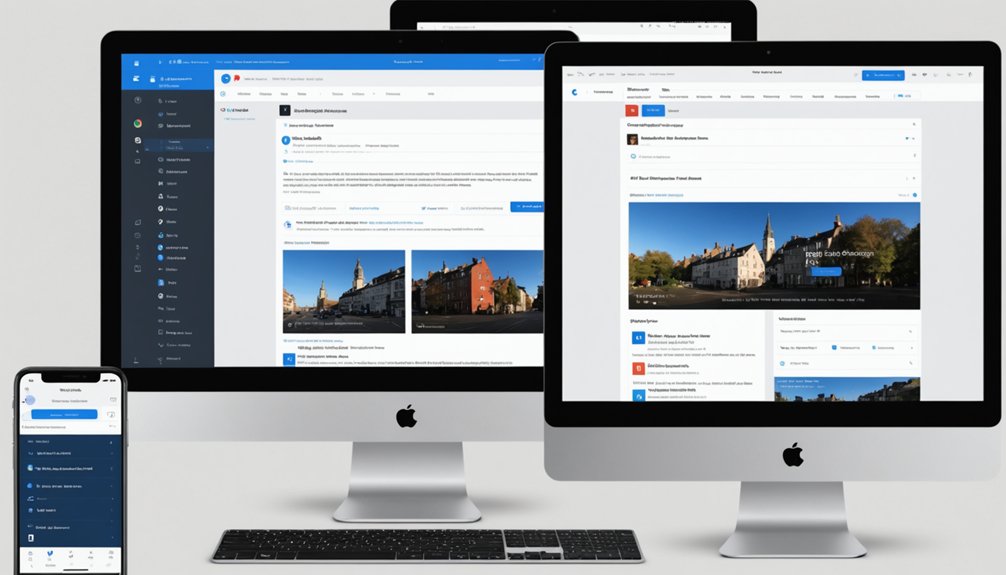Optimizing Twitter for search isn’t rocket science, just overlooked opportunity. Start with a keyword-rich profile and professional photo—username matters too. Mix relevant hashtags strategically; five good ones beat fifteen random ones. Post consistently with high-quality, informative content that aligns with search intent. Engage authentically, respond to mentions, and use Twitter’s analytics to track performance. Most companies neglect this while pouring money into websites. The secrets to visibility await beyond the basics.

Optimizing Twitter profiles isn’t just for show—it’s serious business for anyone wanting to stand out in the crowded social media landscape. Companies spend thousands on fancy websites but neglect their Twitter presence. Big mistake. A complete profile with a professional picture, eye-catching header, and keyword-rich bio increases visibility dramatically. Your username matters too—choose something that reflects your brand, not some random combination of letters and numbers.
Keywords aren’t just for websites. They matter on Twitter too. Including relevant industry terms in your bio and tweets helps users find you through search. But don’t stuff keywords like it’s 2005. That looks desperate. Implementing social listening tools helps monitor industry-specific keywords and conversations to refine your content strategy.
Hashtags remain Twitter’s bread and butter. Research shows the right combination of trending and niche hashtags can expand reach exponentially. Quality trumps quantity—five strategic hashtags beat fifteen random ones any day. Branded hashtags? Even better. They build community and increase engagement when followers actually use them.
Content is still king, even with Twitter’s character limits. High-quality, informative tweets that align with search intent perform better. Period. Consistency matters too. Accounts that post regularly see higher engagement than sporadic tweeters. It’s not rocket science. Tools like BillyBuzz tracking can help monitor conversations and measure content performance effectively.
Engagement isn’t optional. Accounts that respond to mentions, participate in Twitter chats, and interact with industry leaders build authority faster. Some brands ignore direct messages for days. Their loss. User-generated content can significantly boost community loyalty and authenticity when shared on your profile.
The smart ones use analytics. Twitter’s native tools provide valuable insights about what works and what flops. Track performance, monitor keyword trends, and adjust content accordingly. Flying blind is for amateurs. Implementing a Twitter scheduler can dramatically improve your consistency and optimize posting times based on when your audience is most active.
Google notices Twitter activity too. Tweets sometimes appear in search results, so aligning content with broader search intent creates additional visibility opportunities. The platforms aren’t isolated islands anymore.
Bottom line: Twitter SEO isn’t complicated, but it requires strategy. Complete profiles, strategic keywords, thoughtful hashtags, quality content, and meaningful engagement. Master these elements, and visibility follows. Ignore them, and prepare to be ignored.
Frequently Asked Questions
How Often Should I Post to Maximize Twitter SEO Benefits?
For maximum Twitter SEO benefits, posting 3-7 times daily hits the sweet spot.
Quality matters though. Consistency builds audience trust. Timing is everything—post when followers are actually online.
Too many posts? Audience gets overwhelmed. Too few? They forget you exist.
Keywords in tweets boost visibility in search results. Smart accounts analyze engagement metrics and adjust accordingly.
Competitor analysis helps too. SEO isn’t just frequency—it’s relevant content that gets indexed by search engines.
Can Twitter Spaces Recordings Improve My SEO Ranking?
Twitter Spaces recordings can indeed boost SEO.
They’re indexed by Google when linked in tweets. Smart move. Content stays relevant long after the live session ends.
The key? Proper tagging and targeted keywords. It’s not direct ranking juice, but the engagement metrics matter.
Repeated sharing increases visibility. Plus, recorded Spaces let people consume your content anytime.
The SEO benefits are indirect but real. Just make sure the content’s actually worth listening to.
Do Quote Tweets Hurt or Help Original Content Visibility?
Quote tweets can be a double-edged sword for content visibility. They typically help by expanding reach to new audiences and boosting engagement metrics.
More eyeballs, more interactions. Simple math.
However, they can hurt when used to criticize or mock the original content. Context gets twisted.
Original message? Lost in translation.
The blocking limitation is real, too. Someone you’ve blocked can still quote tweet you, and their followers will see your content anyway.
Not ideal for everyone.
Should I Delete Underperforming Tweets to Boost Account SEO?
Deleting underperforming tweets can definitely help account SEO. Removing low-engagement content streamlines the profile and improves overall quality signals.
Twitter’s algorithm notices this stuff. Fewer duds means better engagement ratios – something the platform actually cares about.
Not everyone agrees though. Some experts argue historical content shows account longevity.
But reality check: nobody’s scrolling through your ancient zero-engagement tweets. A curated feed looks more professional.
Less digital clutter, better algorithmic performance.
How Do Twitter Algorithm Changes Affect Long-Term SEO Strategy?
Twitter algorithm changes can totally upend SEO strategies. No surprise there.
When the algorithm shifts, visibility patterns change—period. Content that once thrived might suddenly tank. Smart marketers adapt quickly, adjusting their approach to match Twitter’s new preferences.
These changes ripple beyond the platform, affecting overall digital presence. Links get clicked less. Engagement patterns shift. The domino effect is real.
Long-term SEO success requires constant vigilance and flexibility. Algorithm changes aren’t just Twitter’s problem—they’re everyone’s problem.




